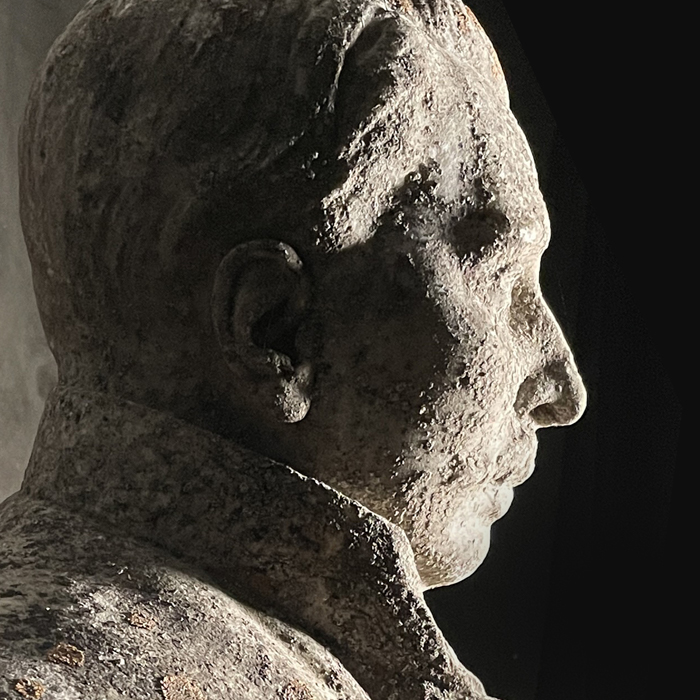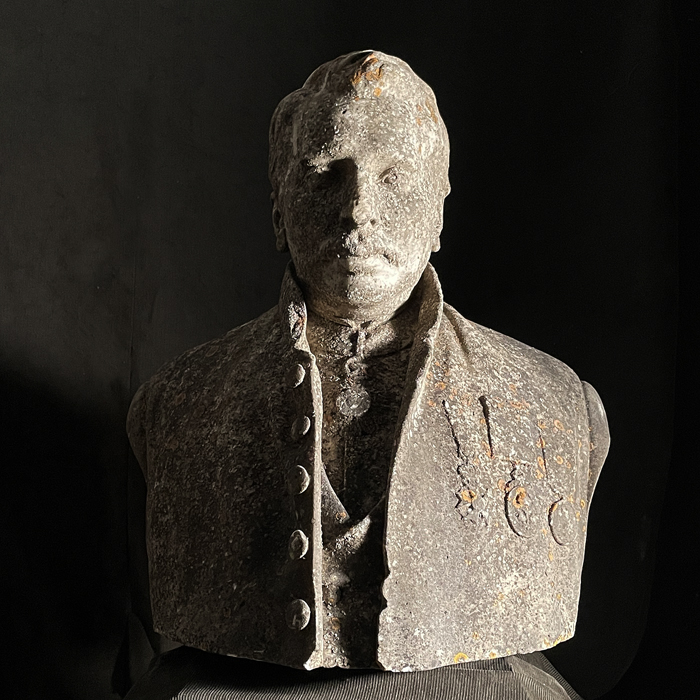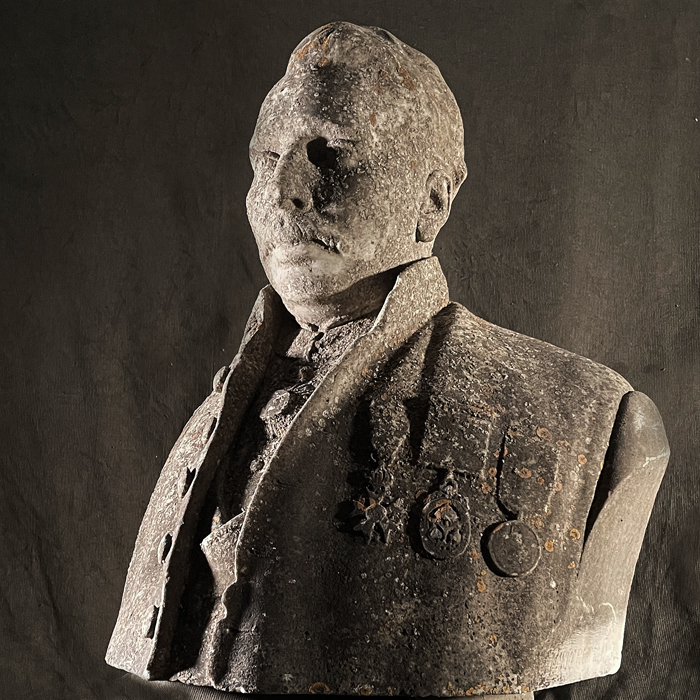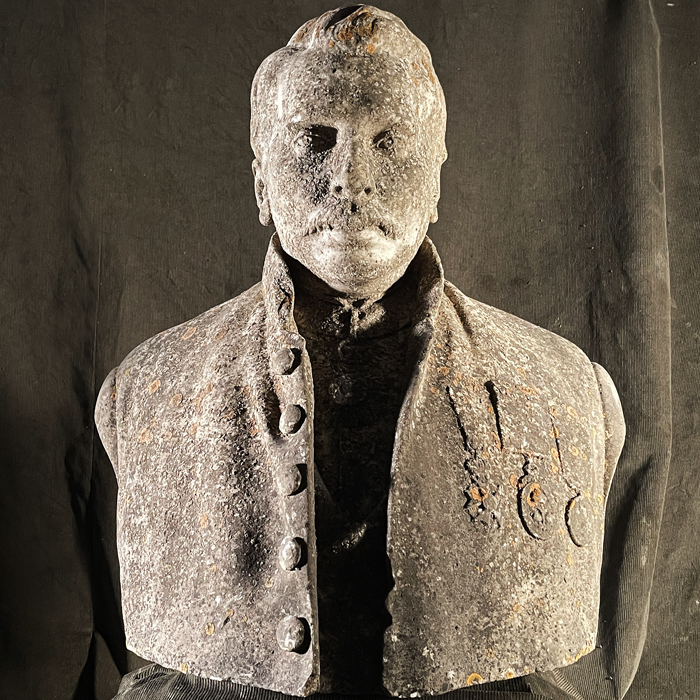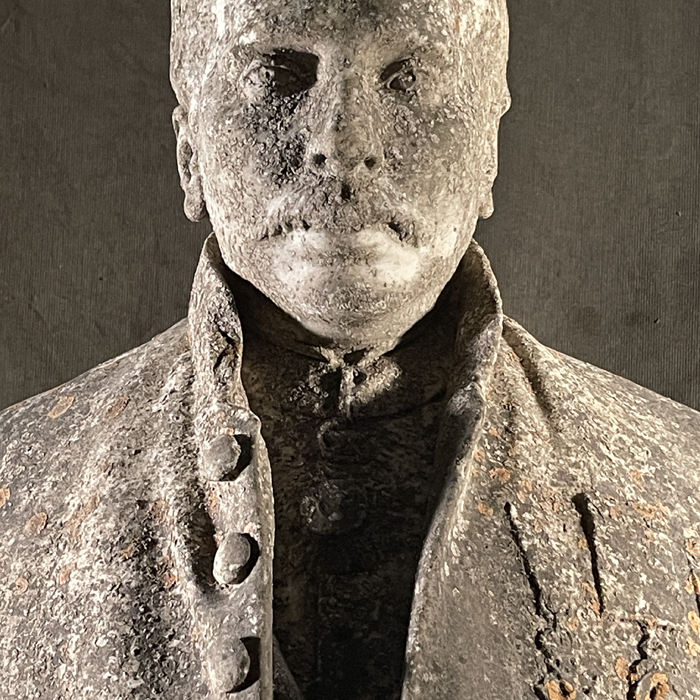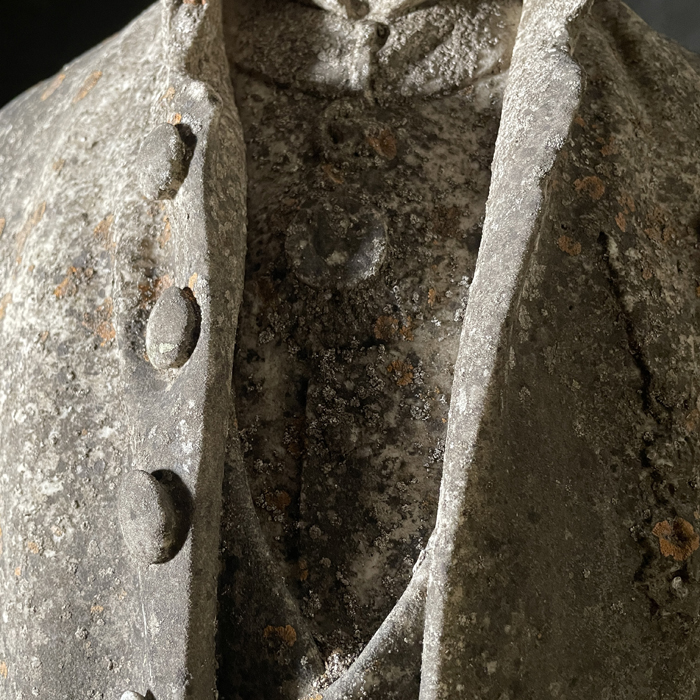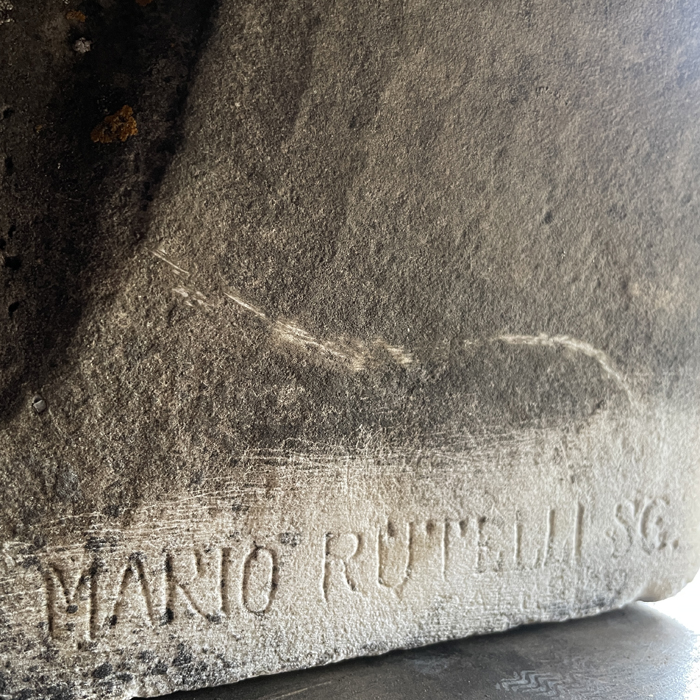An Italian statuary marble bust of the French Ambassador René Besnard
the lifesize moustachioed gentleman, looking straight ahead, with side-parted hair, his buttoned tunic revealing a medal to his neck and three further awards on his chest (one the Legion d'Honneur), the bust evenly weathered with some lichen giving the portrait a melancholic air, signed to the side "MARIO RUTELLI SC."
£8,950
In stock
We think we have correctly identified the sitter as René Besnard (1879-1952) a French lawyer and politician who was appointed ambassador to Rome from 1920 to 1924. His likeness, his time in Rome by which point he was in his early 40’s, and that he was an officer of the Legion d’Honneur (the left hand medal) all make him a strong candidate to have been captured in this marble bust by Rutelli.
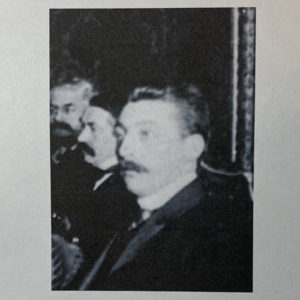
Mario Rutelli (1859-1941)
Rutelli was a prolific and highly sought-after portraitist both in Rome and his home city of Palermo. He also won numerous commissions for civic statuary both in marble and bronze. His work can still be seen in the museums and squares of Rome and Palermo with other examples found as far afield as Cambridge and Aberystwyth. His style adapted beautifully to Art Nouveau at the turn of the century as can be seen in his celebrated “Fountain of the Naiads”. Later he was deemed a favourite sculptor by Mussolini.
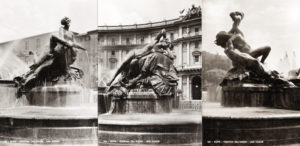
The source of the biography below was gleaned from the entry “Rutelli, Mario” by Francesco Santaniello in “The Biographical Dictionary of Italians” – Vol 89 (2017) – here translated and edited.
Born in Palermo, Mario Rutelli attended various Academies before receiving sculptural work embellishing the new Teatro Massimo – his father’s construction firm was engaged in the building of it. His work there included the group La lirica in 1877 (later cast in bronze).
In 1878 he took part in the World Exhibition in Paris showing Hamlet in marble (location now unknown); he stayed in the French capital for a time and went on to Venice, Florence and Siena to visit galleries and museums.
In 1879 he settled in Rome, where he enrolled at the Royal Academy of Fine Arts, becoming a student of Giulio Monteverde and Ercole Rosa.
He always maintained close ties with Palermo. In 1881 he was commissioned to make the Triton Fountain (also known as L’azione ) for the Cathedral square in Monreale.
In 1883 he exhibited two works: Ave Maria in marble, and Gli iracondi in plaster at the National Exhibition of Fine Arts in Rome.
In 1887 he sculpted the bust of Carlo Maggiorani in marble for the University of Palermo, now in the Great Hall of the Law faculty. In 1889 he created the marble bust of the Marquis of Torrearsa (Sicilian Society for the History of the Country), The Lion of Caprera in bronze, intended for the base of the monument to Garibaldi, and the quadriga depicting The Triumph of Apelles and Euterpe placed to crown the facade of the Politeama theatre.
At the National Exhibition of Palermo in 1891-92 he presented a large group of works: five bas-reliefs, Christ on the Cross (plaster), Childhood (marble), the portrait of the Marquis of Torrearsa (bronze), At the Sea (a bronze group), the portrait of the Duke of Salaparuta (bronze), Vanni Fucci (plaster), the portrait of the painter Paolo Vetri (plaster, Palermo, Civic Gallery of Modern Art), The Lion of Caprera (plaster) and the group The Wrathful Men (plaster).
In 1892, in partnership with his brother Salvatore, he founded the “Fonderia Artistica Siciliana Rutelli” in Palermo, and embarked on the bronze casting of the group Gli iracondi (or Gli irosi , 1883), which was purchased by the “Galleria Nazionale d’Arte Moderna” in Rome (where it can still be seen), and two bas-reliefs The Landing of the Thousand in Marsala and The Battle at the Ponte dell’ Ammiraglio for the equestrian monument of Garibaldi in Palermo.
In the 1890’s Rutelli was very active. He received numerous and important commissions from the municipality of Palermo. In 1893 he worked on the portrait of Emanuele Notarbartolo (marble) and the portrait of Francesco Crispi, destined for the halls of Palazzo delle Aquile, and on the allegorical sculpture La Nautica . The latter, in 1894, was placed in the garden of Piazza Castelnuovo. In 1897 he placed the bronze high relief depicting The Apotheosis of Vittorio Emanuele II in the foyer of the Teatro Massimo.
In 1900 he executed the monument to Nicola Spedalieri, erected in 1903 in Piazza S. Andrea della Valle in Rome (later moved to Piazza Cesarini Sforza).
The following year he started on what was to become his best known (and somewhat controversial) work: The Fountain of the Naiads in Piazza dell’Esedra (Piazza della Repubblica).
The design for the Fountain of the Naiads endured a long bureaucratic process and various construction phases. Rutelli was originally commissioned in 1896 by the Società anonima dell’acqua Pia antica Marcia. He first executed the four supplementary groups of sea nymphs for the fountain. However, their nudity was harshly criticized by the most conservative Capitoline politicians, who even tried to prevent the inauguration. Later, in 1911, Rutelli added the central group with the figure of Glaucus and marine animals, which did not please them either. The fountain was moved to Piazza Vittorio, and was replaced the following year with a second version.
Back in Palermo, Rutelli joined the City Council and carved the portrait of Michele Amari for the great hall of the law faculty and the next year, in 1903, he was called to hold the chair of sculpture at the Royal Institute of Fine Arts. The commission to create the monument to Francesco Crispi followed (completed in 1905).
Rome commissions of this time included the bust of Senator Stanislao Cannizzaro for the Senate Library (1906). And he donated his earlier bronze portrait of Domenico Morelli (bronze, circa 1893) to the National Gallery of Modern Art in Rome.
In 1908 he sent a marble sculpture entitled Life Coming Out of the Brambles to the Saint Louis Exposition (USA) (now in Rome, private collection; reproduced in Mario Rutelli , 1998, p. 100).
From 1909 he began to collaborate with the Royal Mint of Rome by designing a series of commemorative medals.
In 1910 the Civic Gallery of Palermo purchased a bronze version of the Iracondi from Rutelli and a marble portrait bust of Edmondo De Amicis which was placed in the “English Garden”.
In 1911 the artist cast the Winged Victory (bronze) raised above a column of the Vittoriano in Rome (a second version was placed on top of the monument commemorating the fiftieth anniversary of the liberation of Palermo); in May, in Catania, he inaugurated the equestrian monument to Umberto I in the presence of the king.
Between 1916 and 1920 he went to England and Wales several times to work on some monumental works, such as the portrait of King George V (1919) and the portrait of the Prince of Wales (the future Edward VIII) for Aberystwyth University.
In the early 1920s he worked on a series of commemorative monuments. In 1920 he produced the memorial to the naturalist Giuseppe Gioeni, inserted in the facade of the Gioeni-Asmundo Palace, home of the Gioenia Academy of Catania. In 1922 he completed the monument to the fallen sailors of Wales for the city of Aberystwyth. He carved the monument to Gaetano Bucceri at Villa Bonanno in Palermo and the monument to the fallen in Agrigento.
Rutelli returned live in Rome in 1923, only moving back to Palermo in 1935. His works of this period include: a monument to the fallen in Monreale, a bust of Ricciotti Garibaldi for the Gianicolo garden, a portrait of the Marchesa Violet Godi di Godio, the equestrian monument of Anita Garibaldi (placed on the Gianicolo hill) and Maternity, Activity, Garibaldini Sowers (exhibited in Fascist Regional Union of Fine Arts of Lazio).
Mario Rutelli died on 4th November 1941 in Palermo.
Sources and Bibl.: V. Privitera, The medals of MR , in Medaglia , XIV (1986), 21, pp. 74-88; F. Grasso, MR A sculptor between two centuries , in Kalós , 1989, n. 1, monographic supplement: Rutelli , pp. 1-13, 16-32; M. De Micheli, Sculpture of the nineteenth century , Turin 1992, pp. 248, 250, 255; L. Sarullo, Dictionary of Sicilian artists , III, Sculpture , edited by B. Patera, Palermo 1994, pp. 291 ff.; V. Vicario, Italian sculptors from Neoclassicism to Liberty , II, Lodi 1994, pp. 929-934; L. Picone, The monument to Nicola Spedalieri , in Lazio yesterday and today , XXXIII (1997), 7, pp. 216 ff.; R. Messina, The forgotten Sicilian nineteenth century. Three sculptors from Palermo: Benedetto Civiletti, Vincenzo Ragusa and MR , in Dialogues on the history of art , IV (1998), 7, pp. 112-129; MR (catal.), edited by F. Grasso, Palermo 1998; MC Sirchia – E. Rizzo, Liberty in Palermo , Palermo 2001, pp. 41, 43, 48, 98, 100 ff., 117, 128, 203; D. Lacagnina, Studies and sketches by MR for the fountain of the Naiads , in Lazio yesterday and today , XL (2004), 5, pp. 138-141; National Gallery of Modern Art. The collections. The 19th century , edited by E. di Majo – M. Lafranconi, Milan 2006, pp. 72, 212; E. Rizzo – MC Sirchia, Sicilian sculptors. 19th and 20th century , Palermo 2009, pp. 258 ff.


